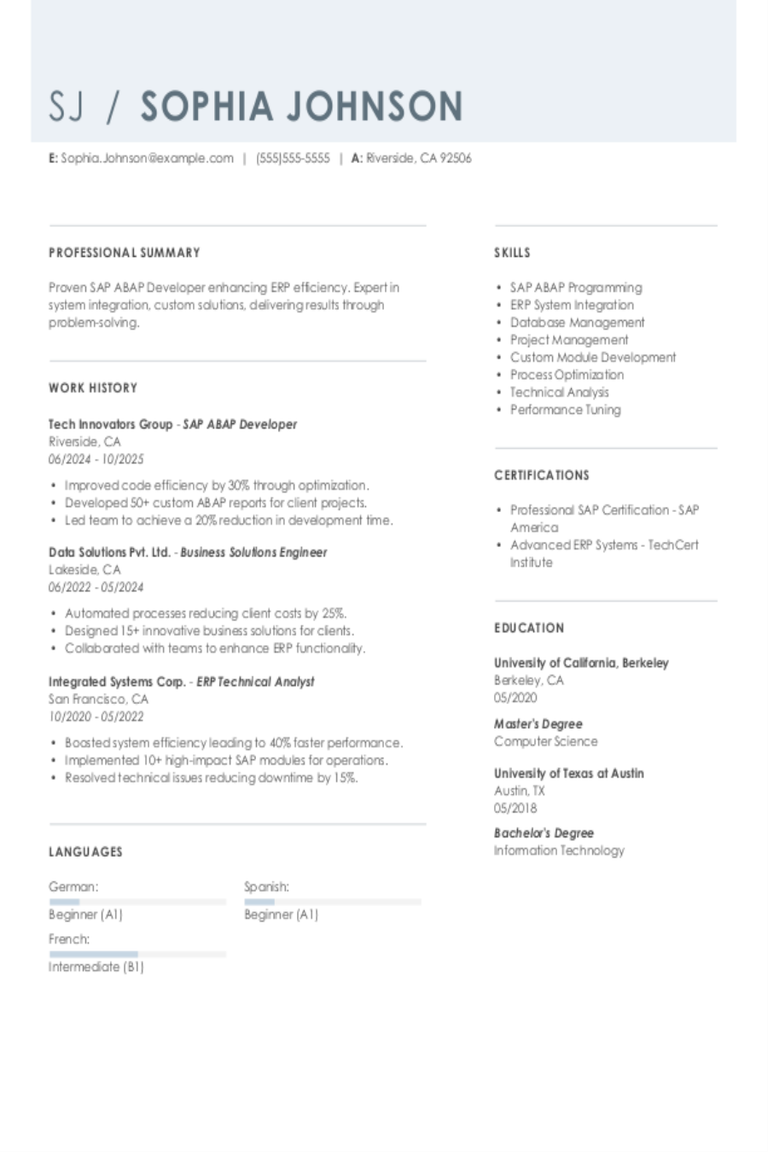Why this resume works
- Quantifies accomplishments: Through accomplishments with metrics, like increasing patient retention by 20% annually and conducting over 500 cleanings with high satisfaction, the applicant effectively captures their impact.
- Highlights industry-specific skills: The applicant showcases essential healthcare skills like dental prophylaxis and infection control techniques, highlighting a strong fit for roles focused on oral health care.
- Illustrates problem-solving ability: Implementing a CRM system to boost clinic efficiency by 25% reflects problem-solving prowess and innovation.
More Dental Hygienist Resume Examples
See our dental hygienist resume examples to learn how to highlight your patient care skills, oral health expertise, and teamwork abilities. These samples will help you craft a resume that impresses employers in the dental field.
Entry-level dental hygienist
Why this resume works
- Centers on academic background: Showcasing a master’s degree in oral hygiene and a bachelor’s in health sciences, the applicant emphasizes strong academic foundations important for early career growth.
- Effective use of keywords: Incorporating role-specific keywords, such as “oral hygiene treatment,” “reducing chair turnover,” and “preventive cleanings” ensures the resume makes it past the applicant tracking systems.
- Shows digital literacy: Skill with dental software and radiographic imaging highlights the applicant’s digital readiness, showing they have the essential computer skills required for modern workplaces.
Mid-level dental hygienist
Why this resume works
- Points to measurable outcomes: By citing specific figures like a 25% increase in patient satisfaction, the applicant vividly illustrates their tangible impact on clinic performance.
- Includes a mix of soft and hard skills: Balancing technical expertise with strong interpersonal skills, the applicant merges dental care skill with effective communication and patient education.
- Demonstrates language abilities: By listing language skills in Spanish, French, and Mandarin, the applicant shows they can communicate with diverse patient communities.
Experienced dental hygienist
Why this resume works
- Lists relevant certifications: By listing certifications like Certified Dental Hygienist and CPR, the applicant showcases commitment to expertise, which bolsters their professional credibility.
- Showcases impressive accomplishments: Achievements such as reducing patient wait times reflect a strategic approach that drives significant impact for business operations.
- Emphasizes leadership skills: Training five dental assistants highlights leadership skills that foster team development and improve efficiency.
Dental Hygienist Resume Template (Text Version)
Sophia Patel
Tampa, FL 33607
(555)555-5555
Sophia.Patel@example.com
Professional Summary
Experienced Dental Hygienist with 9 years optimizing oral health care, improving patient retention by 20%, and enhancing clinic efficiency by 25% through strategic hygiene processes.
Work History
Dental Hygienist
SmileCare Dental Group – Tampa, FL
July 2022 – July 2025
- Increased patient retention by 20% annually
- Conducted 500+ cleanings annually with high satisfaction
- Streamlined hygiene processes saving 10% on costs
Oral Health Specialist
HealthySmiles Clinic – Jacksonville, FL
June 2017 – June 2022
- Reduced appointment cancellations by 15%
- Educated 2000+ patients on oral hygiene
- Improved clinic efficiency by 25% via CRM implementation
Dental Care Coordinator
BrightDental Partners – Miami, FL
January 2016 – May 2017
- Managed patient schedules, boosting efficiency by 30%
- Oversaw supply orders reducing costs by 10%
- Led a team of 5 to enhance patient care services
Languages
- Spanish – Beginner (A1)
- French – Intermediate (B1)
- Italian – Beginner (A1)
Skills
- Dental Prophylaxis
- Patient Education
- Oral Health Assessments
- Preventive Care Procedures
- Digital X-rays Interpretation
- Scaling & Root Planing
- Infection Control Techniques
- Dental Software Proficiency
Certifications
- Certified Dental Hygienist – American Dental Association
- Advanced Oral Care Certification – Dental Institute of America
Education
Master of Science Dental Hygiene
University of Texas Health Science Center San Antonio, Texas
May 2015
Bachelor of Science Dental Hygiene
Texas A&M University College Station, Texas
June 2013
Related Resume Guides
Advice for Writing Your Dental Hygienist Resume
Discover how to craft a standout resume for a dental hygienist position that highlights your skills in patient care and oral health.
Explore our tips on how to write a resume and learn how to effectively present your expertise, from routine cleanings to patient education, making sure your resume shines among the rest.
Write a strong professional summary
A professional summary or a resume objective introduces hiring managers to your qualifications, offering a quick snapshot. It’s key to choose between a summary or an objective based on your career stage and goals.
A professional summary is a brief section at the top of your resume highlighting your experience, skills, and achievements in three to four sentences. It’s ideal for experienced applicants who want to showcase their professional identity and value swiftly. This section showcases what you have achieved in your career so far.
Resume objectives are statements about career goals, perfect for entry-level applicants, those changing careers, or individuals with employment gaps. Summaries focus on past achievements (“what I’ve accomplished”), while objectives highlight future contributions (“what I aim to contribute”).
Next, we’ll provide examples of both summaries and objectives tailored for various industries and experience levels. This will help you effectively present yourself whether you’re a seasoned dental hygienist or just starting out in the field.
Dental hygienist resume summary examples
Entry-level
Recent dental hygiene program graduate with a solid foundation in preventive oral care, patient education, and clinical procedures. Certified in local anesthesia and CPR, skilled in using dental software and maintaining detailed patient records. Eager to contribute to a dental team while providing high-quality care and promoting oral health awareness.
Mid-career
Dental hygienist with over five years of experience in both private practice and community clinics. Proficient in performing cleanings, periodontal assessments, and advanced scaling techniques. Licensed RDH known for building strong patient relationships and implementing effective oral health education programs. Committed to continuous learning and improving patient care through evidence-based practices.
Experienced
Seasoned dental hygienist with expertise in periodontal therapy, patient management, and team leadership. Over 10 years of experience providing comprehensive dental care, including advanced preventative treatments and diagnostics. Holds certifications in laser dentistry and sedation monitoring, recognized for improving clinic efficiency and patient satisfaction through innovative approaches to oral health care.
Dental hygienist resume objective examples
Recent graduate
Detail-oriented and caring recent dental hygiene program graduate aiming to secure a dental hygienist role to apply strong clinical skills and knowledge in preventative oral care. Committed to promoting oral health education and improving patient experiences within a supportive dental practice.
Career changer
Dedicated professional transitioning into the dental hygiene field from customer service, bringing exceptional communication and interpersonal skills. Eager to join a collaborative team as a dental hygienist, focusing on delivering excellent patient care and fostering positive relationships to promote oral health.
Specialized training
Certified dental hygienist with additional training in periodontal therapy seeking an opportunity within a forward-thinking dental office. Passionate about using specialized skills to support comprehensive patient care plans and contribute to the overall health of patients through effective treatment strategies.
Stand out as a dental hygienist with our Resume Builder. Customize expert-written phrases and showcase your skills in just a few clicks!
Include relevant certifications and training
Listing certifications and training is important for dental hygienists because it shows your skills and knowledge in the field. Certifications prove that you have the necessary training to handle dental procedures safely and effectively.
They also help you stand out to employers who are looking for qualified professionals. Creating a dedicated section for these credentials on your resume can make it easier for hiring managers to see your qualifications.
Some certifications for your dental hygienist resume may include:
- Registered Dental Hygienist (RDH) License
- CPR Certification
- Nitrous Oxide Monitoring Certificate
- Local Anesthesia Certification
- Laser Certification for Dental Hygienists
Having these certifications can boost your chances of getting hired as a dental hygienist. They show that you have gone through specialized training and are ready to provide quality care. Make sure to keep this section updated with any new certifications or training you complete.
Example of a certifications section
Registered Dental Hygienist (RDH) License
Issued by: State Dental Board
Expires 2025
Certified Dental Assistant (CDA)
Issued by: Dental Assisting National Board (DANB)
Issued 2023
Basic Life Support (BLS) Certification
Issued by: American Heart Association
Expires 2026
Local Anesthesia Certification
Issued by: State Dental Board
Issued 2022
Choose a chronological resume format if you have steady work history in your field, but opt for a functional or combination format if you’re changing careers, have employment gaps, or want to emphasize skills over job titles.
Showcase your work experience
Showcasing relevant work experience on a resume is key for a dental hygienist because it helps employers understand your skills, accomplishments, and ability to excel in the role. Highlight your professional background using clear, action-oriented language that shows how you’ve contributed to patient care or improved office efficiency.
Always list your work history in reverse-chronological order, starting with your most recent position. Include the job title, employer name, location, and employment dates to create an organized structure that’s easy to follow.
When describing your responsibilities as a dental hygienist, focus on tasks like performing cleanings, taking X-rays, educating patients about oral hygiene practices, and assisting dentists during procedures.
Use measurable results whenever possible—for example: “Educated 50+ patients weekly on proper brushing techniques,” or “Improved patient scheduling efficiency by reducing wait times by 20%.” This not only highlights what you’ve done but also shows the impact of your work.
Keep each bullet point concise while emphasizing key contributions. Employers look for specific examples that demonstrate expertise in areas like periodontal therapy, fluoride applications, and infection control protocols. By tailoring this section with details that align with a dental hygienist’s core responsibilities, you can effectively showcase why you’re a strong fit for the job.
5 dental hygienist work history bullet point examples
- Performed comprehensive dental cleanings for over 20 patients daily, improving oral hygiene and patient satisfaction scores by 15%.
- Educated patients on oral health care techniques, resulting in a 25% reduction in reported cavities among returning clients.
- Assisted dentists during procedures, ensuring seamless operations and reducing chairside time by an average of 10 minutes per patient.
- Implemented a new sterilization protocol that improved safety standards and decreased equipment downtime by 20%.
- Managed patient scheduling and record-keeping for a practice with over 1,000 active charts, increasing appointment efficiency by 30%.
Choose a resume format that highlights your skills and experience clearly, making it easy for potential employers to see your qualifications.
Match your resume with the job description
Tailoring your resume to match job descriptions is essential for standing out to employers and passing through applicant tracking systems (ATS). Many companies use ATS to filter applicants by scanning resumes for specific keywords and phrases from job postings. This means that if your resume doesn’t include these terms, it might not even be seen by a human.
An ATS-friendly resume uses the right keywords and phrases from the job description. By aligning these terms with your skills, you increase your chances of getting noticed by hiring managers. It’s like speaking the same language as the job ad, making sure you meet their needs.
To find the right keywords, carefully read the job posting. Look for skills, qualifications, and duties that are mentioned more than once. For example, in a dental hygienist role, terms like “patient care,” “clinical assessments,” or “healthcare team collaboration” are important to include exactly as they appear.
Incorporate these terms naturally into your resume content. For instance, instead of writing “Provide high-quality patient care,” say “Delivered high-quality patient care to improve overall health outcomes.” This keeps your experience relevant and aligned with what employers seek.
Customize your resume to show you’re a good match for the position. Targeted resumes are more likely to get past ATS filters and catch an employer’s eye because they show you’re a good fit for the role.
Make your resume shine! Our ATS Resume Checker reviews your resume and gives quick tips to boost your chances with hiring managers.
Salary Insights for Dental Hygienists
Salaries can change depending on where you live and what job you have. The U.S. Bureau of Labor Statistics gives data so you can compare earnings and make smart choices. More details are provided below.
Top 10 highest-paying states for dental hygienists
Dental Hygienists earn varying salaries across the United States, with a national average of $90,483. The table below highlights the states where dental hygienists command the highest compensation.
Our salary information comes from the U.S. Bureau of Labor Statistics’ Occupational Employment and Wage Statistics survey. This official government data provides the most comprehensive and reliable salary information for dental hygienists across all 50 states and the District of Columbia. The figures presented here reflect the May 2025 dataset, which is the most recent available as of this publication.
| State | Average Salary |
|---|---|
| District of Columbia | $130,850 |
| California | $127,090 |
| Washington | $125,090 |
| Alaska | $118,010 |
| Oregon | $115,130 |
| Maryland | $104,980 |
| Delaware | $102,530 |
| Massachusetts | $101,050 |
| Nevada | $101,590 |
| Virginia | $98,500 |
FAQ
Do I need to include a cover letter with my dental hygienist resume?
Adding a cover letter to your dental hygienist resume can boost your application and help you stand out to hiring managers.
A cover letter lets you show your excitement for the job, emphasize skills like patient management or advanced cleaning techniques, and explain why you’re a great fit for the dental practice.
If the dental office focuses on certain procedures like pediatric dentistry or cosmetic treatments, mention any experience or interest in those areas to show you align with their services.
Leverage tools like our Cover Letter Generator to create a personalized document that highlights key achievements and adds depth to your professional story.
Also, check out cover letter examples tailored for healthcare roles or specifically browse through a dental hygienist cover letter for more targeted ideas.
How long should a dental hygienist’s resume be?
For a dental hygienist, you should strive for a one-page resume that highlights key skills such as expertise in oral health education, skill with dental tools and technology, and strong patient communication abilities without overwhelming the reader.
If you have extensive experience or additional specialized certifications relevant to dental hygiene, extending to a two-page resume can be appropriate. Ensure every detail is directly related to your role as a dental hygienist and focuses on recent achievements or responsibilities that demonstrate your capabilities.
Explore our guide on how long a resume should be for examples and tips on determining the ideal length for your career stage.
How do you write a dental hygienist resume with no experience?
When writing a dental hygienist resume, especially if you have no experience, it’s important to emphasize your education, skills, and any relevant training that prepares you for the job. Check out this guide on crafting a resume with no experience for more detailed tips.
- Emphasize your education: Start with your degree in dental hygiene. Include the name of the institution, graduation date, and any honors or relevant coursework.
- Showcase clinical practice: Detail your clinical training from school. Mention specific procedures you practiced such as cleaning teeth, taking X-rays, or educating patients on oral care.
- Highlight certifications: List any relevant certifications like CPR or additional dental-related courses that demonstrate your commitment to the field.
- Include transferable skills: Emphasize soft skills like communication, attention to detail, and patient care which are essential in a dental setting. If you’ve worked in customer service roles before, mention how they helped you develop these skills.
For more guidance on crafting an effective entry-level resume, consider checking out online templates specifically designed for healthcare professionals.
Rate this article
Dental Hygienist
Additional Resources

Dental Hygienist Cover Letter Example + Tips
In addition to following the lead of the free dental hygienist cover letter sample above, here are some more tips to keep in mind as you write your own cover

Dental Receptionist Resume Examples & Templates for 2025
As a dental receptionist, your resume needs to show how you greet patients, manage appointments, and handle billing. Use our resume examples and tips to help you showcase your communication

Dental Lab Technician Resume Examples & Templates for 2025
Explore dental lab technician resume examples that showcase skills in creating dental prosthetics and using lab equipment. Follow our tips to effectively highlight your experience and show employers your precision

Dental Office Manager Resume Examples & Templates for 2025
Learn how dental office managers can highlight their organizational skills and patient care experience. Use our resume examples and tips to discover how to showcase your scheduling abilities and office

Dental Assistant Resume Examples & Templates for 2025
To stand out as a dental assistant, your resume needs to highlight patient care, office support, and hands-on dental skills. Find tips to create a resume that proves you’re ready

SAP ABAP Developer Resume Examples & Templates for 2025
Explore SAP ABAP developer resume examples and tips to learn how to spotlight your skills in coding, debugging, and system enhancements to stand out to hiring managers.Build my resumeImport existing
